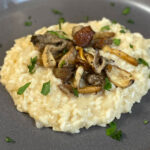Wild Mushroom Risotto
In my mushroom risotto, I love using wild mushrooms of all kinds. There is something about the flavor and texture that is just utterly satisfying, no matter if you follow a plant-based diet or not. For this particular mushroom risotto, I used oyster mushrooms, chestnut mushrooms, and some Lion’s Maine. If you can’t find these particular mushrooms where you are, feel free to use any mushrooms of your choice, ideally a couple of different kinds so you can enjoy the variety of flavors and textures.
- Yield: 4 1x
- Category: Main
Ingredients
About 4 cups (1 liter) vegetable broth warmed
2 tablespoons white miso (optional)
4 tablespoons extra-virgin olive oil
8 ounces (225 grams) fresh wild mushrooms, cleaned and sliced
2–3 sprigs thyme stems removed, leaves chopped
1/2 yellow onion, finely chopped (about 1/2 cup)
1 cup (150 ml) Arborio rice
1/2 cup (125 ml) white wine
½ cup (45 grams) grated vegan Parmesan, plus extra for serving (I like the Follow Your Heart or Go Veggie brand, already grated or Violife’s block of parmesan)
1 tablespoon vegan butter (like Earth Balance or Miyoko’s)
Sea or kosher salt and freshly ground black pepper to taste
Handful of flat-leaf parsley, finely chopped, for garnish (optional)
Instructions
First, pour the broth in a medium pot with the optional miso (adds extra umami flavor) and place over low-medium heat. It’s important to keep the broth warm while gradually ladling it into the risotto to ensure even cooking.
For the wild mushrooms:
In a medium skillet over medium heat, heat 2 tablespoons olive oil and the chopped thyme and heat for about 30 seconds until fragrant, then add the mushrooms.
Cook the mushrooms, stirring frequently until they have slightly browned and released some (but not all) of their water, about 5 minutes. The mushrooms should remain plump, not mushy. Add 2 large pinches of salt halfway through cooking.
Remove the pan from the heat and set the mushrooms aside on a plate.
For the risotto:
Place a medium-sized heavy-duty sauté pan over medium heat and add 2 tablespoons olive oil. Toss in the onion and cook until softened and translucent, about 5-10 minutes; be careful to not let the onion brown.
Add the rice and stir well to coat. Continue stirring until the rice is lightly toasted and becomes translucent, about 2 minutes, then add the wine. Stir the rice until the wine evaporates, about 1 minute, then add 1 cup of the broth.
Continue stirring constantly to prevent the rice from sticking to the pan, until the broth has been absorbed, about 3 minutes. Repeat with ladling another cup of broth until almost absorbed, then continue until the rice is cooked, not mushy but has a good texture/consistency and is al dente. The rice should not have absorbed all the liquid but have a little liquid left.
Remove from the pan and stir in the vegan Parmesan cheese and butter.
Season with salt and pepper to taste.
The risotto should be creamy and loose, not firm and dry.
Garnish with chopped parsley if using and pair with Querciabella’s 2017 Chianti Classico!
Notes
1. Care about the rice you use. The quality and creaminess of the risotto will depend on it.
There are several varieties of rice used to make risotto, the most widely available is arborio, which is not as starchy as other varieties and not as efficient at absorbing liquid. Then you have carnaroli, often dubbed ‘the caviar or king of Italian rices’, which in my opinion makes the creamiest risotto and is harder to overcook. There is also vialone nano, commonly seen in the Veneto region, and also produces a very creamy risotto. Baldo, maratelli, and calriso are additional varieties, but the three aforementioned are perhaps the ones you’ll see most often. The problem with most risottos that aren’t made well is that they get mushy on the outside and crunchy on the inside due to uneven cooking.
2. Speaking of uneven cooking: Make sure your stock/broth is warm as you ladle it a little at a time into the rice.
Resist the urge to dump in all the liquid at once. It’s very important to keep the liquid warm and to gradually add the broth. Yes, it will require your standing at the stove for 20 minutes—but once you take a bite into your perfectly cooked risotto, you won’t have minded at all!
3. Use a wide, shallow skillet. This also aids in the even cooking of your risotto.
4. Don’t ever rinse your risotto rice! The starch on the outside is needed to make the risotto creamy, the center of success for the dish!
5. Make sure to cook any toppings (like the mushrooms) separately and not with the rice, to prevent overcooking.
Find it online: https://sunnygandara.com/wild-mushroom-risotto/
